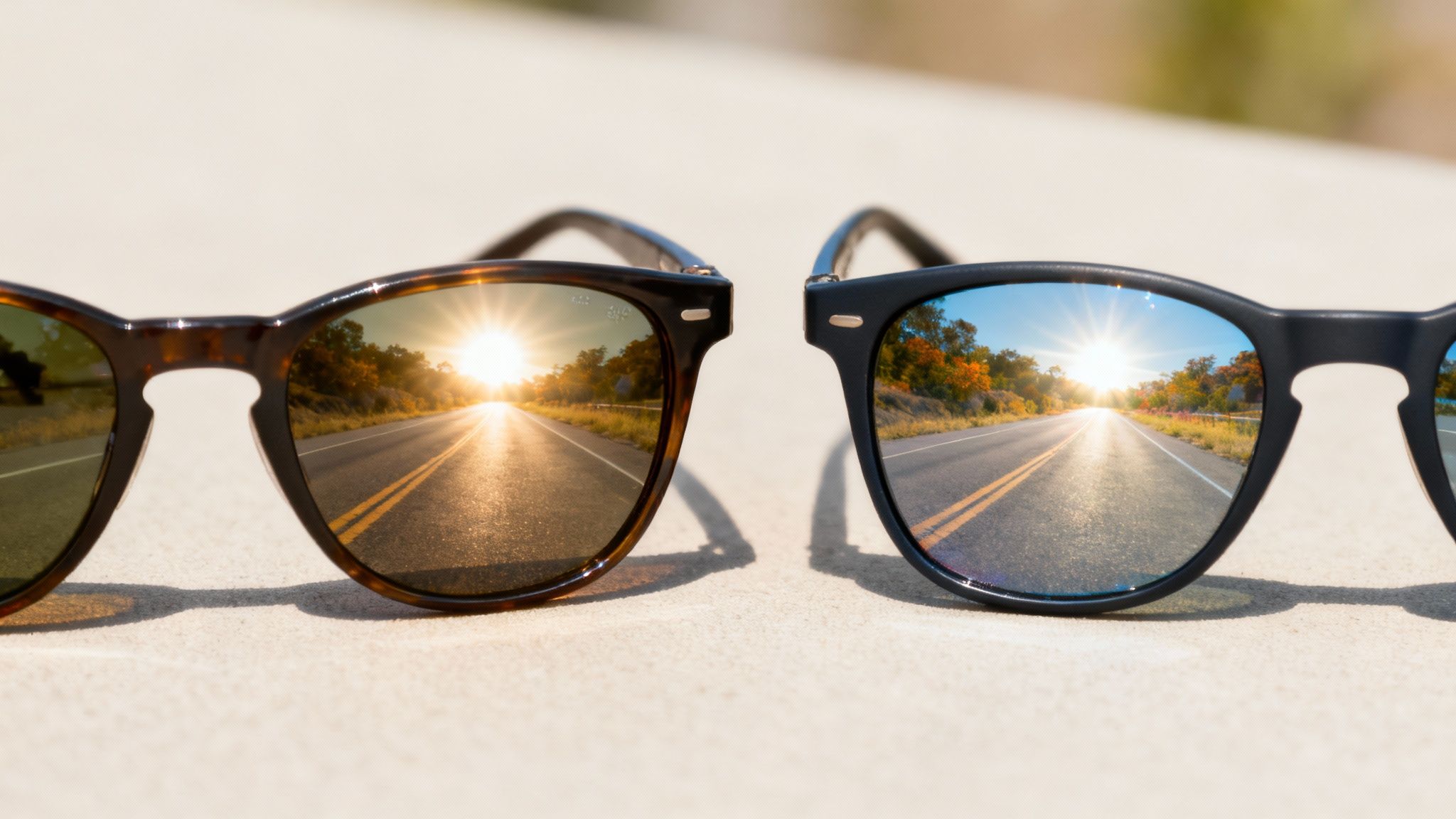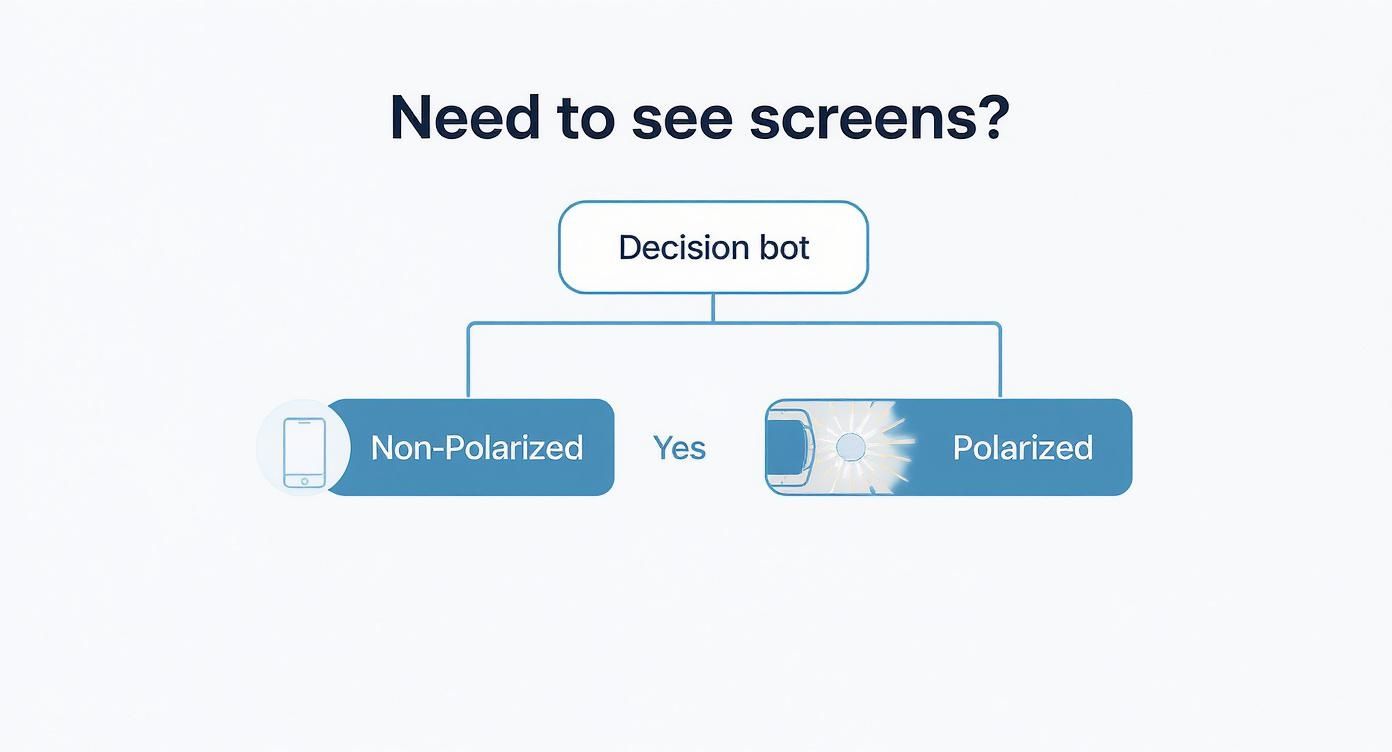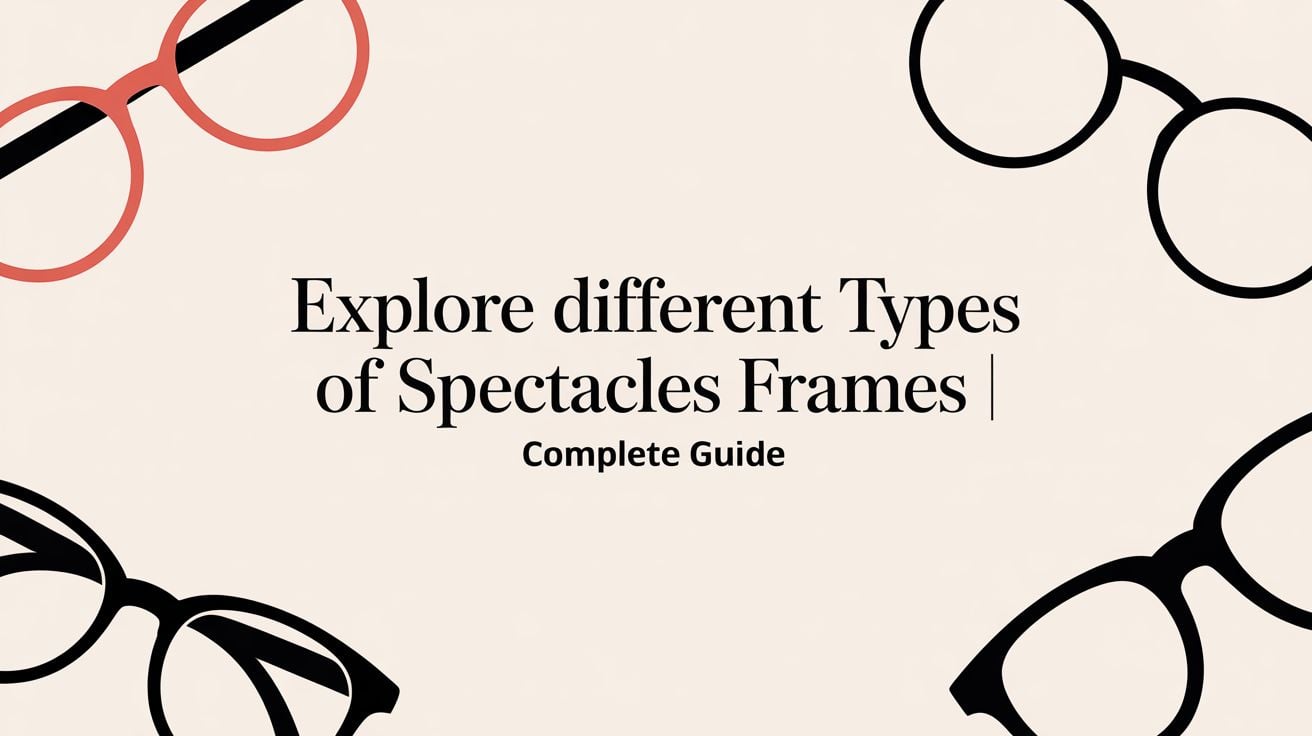Stuck on whether to choose polarized or non-polarized sunglasses? It’s a common question we hear at our Glendale Heights boutique, and the answer really comes down to how you plan to use them.
Think of it this way: non-polarized lenses are like a dimmer switch for the world, simply turning down the overall brightness. On the other hand, polarized lenses have a special filter that acts like a smart gate, specifically blocking the harsh, blinding glare that reflects off flat surfaces. This is the kind of glare you experience driving down North Avenue after a rain shower or see bouncing off the water at East Branch Forest Preserve.
Here at iDoctor in Glendale Heights, we want you to feel completely confident when you pick out a pair of sunglasses. Understanding this key difference is the first step to finding the perfect eyewear for your lifestyle.
What’s Really Happening Behind the Lens?
When you’re picking out sunglasses, the most important thing to remember is that both quality polarized and non-polarized lenses should offer 100% UV protection. That part is non-negotiable for your eye health. The real difference is in how they handle visible light and, more specifically, glare.
Non-polarized lenses are straightforward. They have a tint that darkens your view evenly, which makes bright, sunny days less squint-inducing and much more comfortable. They reduce the total volume of light reaching your eyes without altering how you perceive it.
Polarized lenses are more sophisticated. They contain a chemical film with a vertical pattern that blocks the horizontal light waves responsible for reflective glare. This is the light that bounces off a wet road, a frozen pond, or the hood of a car, creating a distracting and sometimes dangerous visual obstruction. By filtering it out, polarized lenses don't just darken the scene—they make it clearer and with better contrast.
How the Market Breaks Down
The numbers tell an interesting story about how people choose their lenses. In 2024, polarized sunglasses dominated the specialty segment, capturing a massive 81.31% of the global market share. People who need high-performance eyewear for specific activities overwhelmingly choose polarization.
However, if you look at the entire sunglasses market, non-polarized lenses still made up 78.3% of all sales in 2023. This is because they are common in fashion-forward frames and more budget-friendly options, making them a perfectly suitable choice for everyday, casual wear. It’s clear that while polarization is a sought-after premium feature, non-polarized lenses are still the go-to for general use.
Key Differences at a Glance
To make the choice easier, we've broken down the core differences in this quick-reference table. It's a great starting point for figuring out which lens technology aligns with your lifestyle.
| Feature | Polarized Lenses | Non-Polarized Lenses |
|---|---|---|
| Primary Function | Eliminates reflective glare | Reduces overall brightness |
| Visual Experience | Enhanced contrast and clarity | Uniform darkening of the scene |
| Best For | Driving, fishing, water and snow sports | General daily wear, viewing digital screens |
| Screen Compatibility | Can distort or black out LCD/LED screens | No interference with digital displays |
This table gives you the basics, but there's always more to learn. If you're curious about other lens options, feel free to check out our guide to the different types of eyeglass lenses for a deeper dive.
How Polarized Lenses Eliminate Glare
To really get the difference between polarized and non-polarized lenses, it helps to dive into the science. Think of sunlight as light waves traveling in all directions. When these waves hit a flat surface—like a wet patch on Bloomingdale Road or the hood of a car in a Glendale Heights parking lot—they bounce off and align horizontally. This concentrated, horizontal light is what hits our eyes as that blinding, distracting glare.
This is where the genius of polarized lenses comes into play. They’re made with a special chemical filter that's arranged in a vertical pattern, kind of like microscopic Venetian blinds built right into the lens.
The Filtering Effect Explained
That vertical pattern in the filter acts as a gatekeeper. It only lets vertically oriented light pass through to your eyes, while physically blocking the horizontal light waves that cause glare.
The effect is immediate and noticeable.
- Reduced Eye Strain: Your eyes can finally relax instead of constantly squinting against harsh reflections.
- Sharper Contrast: By cutting out all that "visual noise," objects look crisper and more defined.
- More Vibrant Colors: Without the washout from intense light, colors appear richer and more true-to-life.
At iDoctor, we believe patient education is key. Understanding this simple yet effective technology helps our clients appreciate why investing in quality polarized lenses is a significant upgrade for their visual comfort and safety, especially here in the Chicagoland area.
The Growing Demand for Glare-Free Vision
Polarization isn't just a luxury feature anymore; it's quickly becoming a standard for anyone who spends a lot of time outdoors. The global market for polarized sunglasses was valued at roughly $6.25 billion in 2025 and is expected to reach $8.31 billion by 2030. This surge is fueled by a growing awareness of eye health, with North America leading the way in demand for premium eyewear. You can explore the full market analysis on Mordor Intelligence to see how these trends are shaping the industry.
While polarization is fantastic for wiping out glare from external surfaces, other lens treatments handle different types of reflections. Anti-reflective coatings, for instance, are designed to reduce the reflections you see on the back of your lenses. To round out your knowledge, check out our article on the benefits of anti-reflective lens coatings.
What About Non-Polarized Lenses?
While polarized lenses are built to tackle a very specific kind of glare, non-polarized lenses have a different job. They're the classic, all-purpose workhorse of the sunglass world, designed for one simple thing: to reduce the overall intensity of bright light and make you more comfortable.
Think of them like a volume knob for sunlight. The tinted lenses turn down the total amount of light hitting your eyes, which stops you from squinting and makes a bright day far more pleasant. This uniform light reduction is their main strength, and they're fantastic for most everyday situations.
When Simplicity Is a Strength
The whole polarized vs. non-polarized debate really boils down to how you'll be using your glasses. One of the biggest wins for non-polarized lenses is their flawless performance with digital screens.
They don't have that special chemical film that can make LCD and LED displays look weird or even completely black out. This makes non-polarized lenses the go-to choice for:
- Pilots and equipment operators who need a crystal-clear view of their instrument panels at all times.
- Anyone who uses a smartphone or GPS outdoors and needs the screen to be perfectly readable from any angle.
- Drivers who rely on digital dashboards or heads-up displays for crucial info.
In our modern, screen-filled lives, this is a huge practical advantage.
At iDoctor, every pair of high-quality non-polarized sunglasses provides 100% UV protection. This is an absolute must for protecting your vision, ensuring your eyes are safe from damaging ultraviolet rays, filter or no filter.
Your Go-To for Everyday Versatility
For casual, day-to-day wear, non-polarized lenses are an excellent and often more budget-friendly option. They're perfect for a walk through Glendale Heights, running errands, or just enjoying a sunny day that doesn’t involve blinding glare from water or snow.
Some people simply prefer the true-to-life view that non-polarized lenses offer. If you’re looking for a lens that adjusts on its own, you might want to see how light-adaptive lenses stack up. Check out our detailed guide on the pros and cons of photochromic lenses to find out if they're a better match for your needs.
At the end of the day, the right lens is the one that fits your lifestyle, and non-polarized options deliver outstanding clarity and protection for a huge range of activities.
Choosing the Right Lens for Your Lifestyle
Figuring out whether to go with polarized or non-polarized lenses isn't about which one is superior overall. It's about what’s right for your life. The best choice really hinges on how you spend your days, whether that’s navigating traffic on I-355 or just relaxing at Camera Park. Let’s break down a few common scenarios to help you make a smart decision.
What matters most is context. A lens that's perfect for a day on the water might be a hassle on your daily commute. Your lifestyle is the ultimate guide to the kind of lens technology your eyes need.
This simple chart is a great starting point for figuring out which lens type fits your needs.
As you can see, the biggest trade-off comes down to screen visibility versus maximum glare reduction. This is almost always the key factor when people are deciding between the two.
For the Daily Commuter and Driver
If you spend a lot of time behind the wheel, especially during those bright morning or late-afternoon drives, polarized lenses are the undisputed champion. The blinding glare that bounces off wet pavement, other cars, and even your own dashboard is horizontal light—and that’s precisely what polarized filters are built to block.
By cutting out that specific kind of glare, polarized lenses offer some serious benefits:
- Enhanced Safety: With clearer vision, you can spot road hazards, pedestrians, and other cars much more easily, which can improve your reaction time.
- Reduced Eye Strain: Less squinting means your eyes are more relaxed. This can lead to less fatigue and fewer headaches after a long drive.
- Improved Clarity: You'll notice crisper details and richer colors without that washed-out look that harsh sunlight can cause.
For anyone driving around the Chicagoland area, the boost in safety and comfort makes polarized lenses a fantastic investment.
For Outdoor Enthusiasts and Athletes
When you're enjoying the great outdoors, the best lens choice really depends on the specific activity.
Polarized Lenses Excel In:
- Water Activities: If you're fishing, boating, or kayaking on Lake Michigan, polarized lenses are a game-changer. They cut right through the surface glare so you can see what’s going on beneath the water.
- Snow Sports: Just like water, snow produces an intense horizontal glare. Polarization cuts this down dramatically, giving you better visibility on the slopes.
Non-Polarized Lenses Are Often Preferred For:
- Mountain Biking & Trail Sports: Some athletes find that polarized lenses can alter their depth perception, especially in areas with quick shifts between light and shadow. This can make it tricky to spot things like icy patches or slick tree roots.
- Golf: This one is a matter of personal preference. Some golfers love how polarization reduces glare on fairways and water hazards, while others prefer non-polarized lenses for a more consistent view when reading the subtle slopes of the green.
For Screen-Heavy Lifestyles and Pilots
In this category, non-polarized lenses have a clear and crucial advantage. The filtering technology in polarized lenses can make LCD screens—like those on your smartphone, GPS, or even some car dashboards—look distorted, splotchy, or completely black.
If your job or daily routine involves constantly looking at a digital display, choosing non-polarized lenses will save you a ton of frustration. It’s the main reason why pilots and heavy equipment operators almost exclusively wear non-polarized sunglasses.
To help you sort through these scenarios, here’s a quick-reference table that matches common activities with the recommended lens type.
Polarized vs Non-Polarized Use Case Recommendations
| Activity/Situation | Recommended Lens | Reasoning |
|---|---|---|
| Daily Driving | Polarized | Significantly reduces glare from roads and other cars, improving safety and comfort. |
| Boating/Fishing | Polarized | Cuts surface glare on the water, allowing you to see beneath the surface. |
| Skiing/Snowboarding | Polarized | Minimizes intense glare reflecting off the snow, enhancing visibility. |
| Using Digital Screens | Non-Polarized | Prevents the screen blackout effect common with polarized lenses on LCD/LED displays. |
| Flying (as a pilot) | Non-Polarized | Ensures clear visibility of cockpit instruments and digital flight displays. |
| Golfing | Either (Personal Preference) | Polarized lenses reduce glare, but some prefer non-polarized for reading greens. |
| Hiking/Trail Running | Either (Personal Preference) | Some find polarization alters depth perception in changing light. |
Ultimately, choosing the right lens is a personal decision based on your unique visual needs and daily habits.
Making that final choice involves weighing these situations against your own routine. As you explore options, keep in mind that tools like virtual try-on technology can make it easier to find the perfect style. Of course, the team here at iDoctor is always ready to give you a personalized recommendation based on exactly what you need.
How Designer Brands Elevate Your Lens Choice
Picking between polarized and non-polarized lenses is a big decision, but don't forget about the frames and the lens material itself. They're just as crucial to how much you'll love your new sunglasses. At iDoctor, we firmly believe that great vision and great style should go hand-in-hand. That's why we carry a curated collection of luxury eyewear from brands like Cartier, Gucci, and Tom Ford alongside accessible favorites like Ray-Ban and Kate Spade.
When you choose a pair of sunglasses from Tom Ford, Cartier, or Oliver Peoples, you’re getting more than just a famous name. These brands are obsessed with superior optical engineering. This ensures that whether you go with their polarized or non-polarized options, you're guaranteed pristine clarity and 100% UV protection.
Beyond the Brand Name
Luxury eyewear is about so much more than just a logo. The real difference lies in the quality of the materials, from the temple tips to the lens core.
- Advanced Lens Materials: Many of our designer frames come with lenses made from advanced materials like polycarbonate. It’s incredibly lightweight and seriously impact-resistant, making it a fantastic, durable choice for anyone with an active lifestyle. You get visual comfort and peace of mind.
- Superior Frame Construction: High-end brands use premium materials you can feel, like rich Italian acetate and feather-light titanium. Not only are these materials more comfortable and built to last, but they also hold their shape over time, keeping your lenses perfectly aligned for the best possible vision.
Custom Solutions for Unmatched Style
So, what happens if you fall in love with the perfect Gucci or Prada frame, but it doesn't have the specific lens you need? At iDoctor, that's not a problem at all. We specialize in creating custom prescription and non-prescription sunglass lenses for almost any frame we offer.
This lets you have it all: the iconic style you want, paired with the exact lens technology your life requires. Whether you need polarized prescription lenses for your daily commute or a specific non-polarized tint for everyday wear, our lab can build a custom solution just for you.
Our promise is to provide Glendale Heights with eyewear that perfectly marries function and fashion. You should never have to compromise between the frames you love and the vision you need.
The eyewear world is always pushing forward, especially when it comes to lens technology. In fact, the polarized sunglass lens market is projected to hit $560 million by 2025, fueled by innovations that are making lenses lighter and tougher than ever. This trend is especially noticeable in sports eyewear, where polarized options captured over 55% of the market in 2023. You can see how the polarized lens market is evolving and learn more about the tech. This constant improvement means the designer eyewear we stock always features the best technology on the market.
Find Your Perfect Sunglasses in Glendale Heights
So, what's the final verdict? Polarized or non-polarized? The truth is, it all boils down to your lifestyle and what your eyes need to feel comfortable. We've talked about how polarized lenses are the champions of cutting down blinding glare, but sometimes the simple, effective protection of non-polarized lenses is all you need.
The best way to really understand the difference is to see it with your own eyes. At iDoctor, you can try both and see what feels best after one of our detailed eye exams in Glendale Heights.
At iDoctor, our team here in Glendale Heights is ready to help you sort through the options. We can talk about your daily routine—maybe you're always driving down Schmale Road dealing with sun reflections, or perhaps you just need a great all-around pair for running errands on the weekend. Whatever your situation, we'll guide you to the right choice.
Your vision is one-of-a-kind, and your sunglasses should be too. We're here to find a pair that doesn't just protect your eyes but also fits your personal style and handles whatever your day throws at it.
Come by our boutique and browse our collection of designer sunglasses from top brands like Ray-Ban, Gucci, and Tom Ford. Our opticians will have you try on different lens types so you can experience that visual clarity for yourself. Let's find you a pair that perfectly balances great looks with practical function.
Feeling confident in your choice is what it's all about. For a little more help on what to consider, take a look at our guide on how to choose the right sunglasses for your needs.
Your Polarized Lens Questions, Answered
Deciding between polarized and non-polarized lenses brings up a lot of questions. As the team at the best optometrist in Glendale Heights, we've heard them all. Here are answers to some of the most common things people ask us.
Are polarized lenses a must-have for driving in Glendale Heights?
For driving around Glendale Heights and the Chicagoland suburbs, we highly recommend polarized lenses. They are a game-changer for cutting down the harsh glare you get from wet roads after a rainstorm, bright reflections bouncing off other cars on I-355, or that blinding low sun on the horizon. Regular sunglasses just make everything darker, but they don't tackle the specific, vision-blocking glare that causes you to squint. By eliminating that glare, polarized lenses make driving more comfortable and can even improve your reaction time—a huge plus for safety.
Can iDoctor put my prescription in designer sunglasses?
Yes, absolutely! That’s one of our specialties. We offer a fantastic selection of designer eyeglasses in Glendale Heights from top brands like Gucci, Cartier, and Tom Ford, and our expert opticians are skilled at fitting them with custom prescription lenses. Whether you decide on polarized or non-polarized lenses, we can craft them to your precise vision needs. You get the style you want with the crystal-clear vision you need. And since we accept all major vision insurance plans, getting into a pair you love is easier than ever.
From an eye health standpoint, are polarized lenses better?
When it comes to protecting your eyes from the sun, the number one priority is 100% UV protection. Any quality pair of sunglasses from a trusted source like iDoctor, whether polarized or not, should offer that. The main health advantage of polarized lenses comes down to reducing eye strain. Constant glare forces your eyes to work overtime, leading to fatigue and discomfort. By filtering out that intense light, polarized lenses help your eyes relax, which is a big deal if you're outdoors for long periods. If you're wondering how this technology combines with others, we dive deeper into whether transition lenses can be polarized in another post.
Ready to see the difference for yourself? Visit iDoctor in Glendale Heights for a personalized consultation and explore our curated collection of designer eyewear. Find your perfect pair today at https://idoctoril.com.







